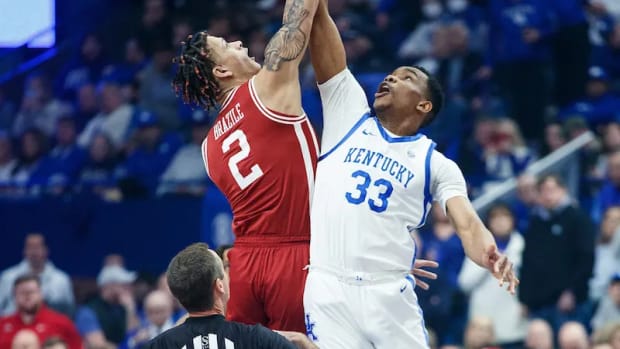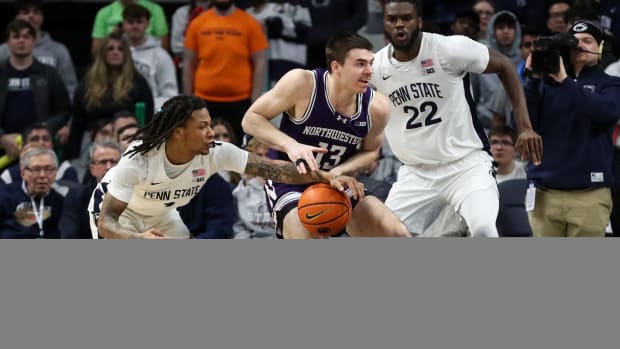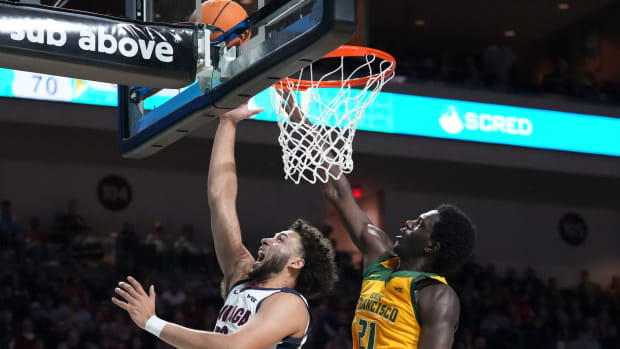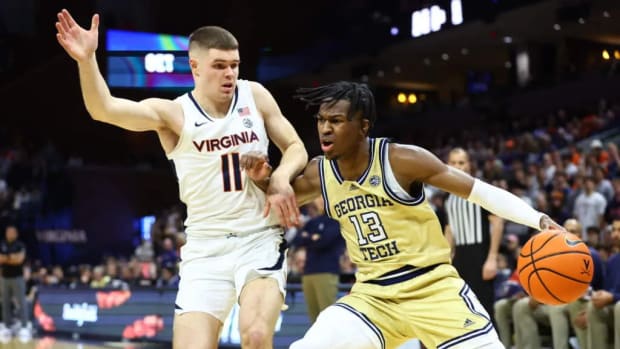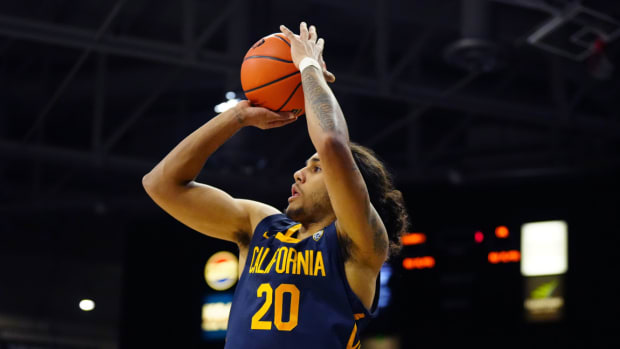
College basketball's new recruiting epicenter: Washington D.C.
The question: "What is the best area of the country for producing college basketball players?"
Miami assistant coach Chris Caputo offered the answer: "Go look up the 2004 All-Met team," said Caputo, who knows the D.C.-Baltimore corridor as well as any coach from his nine years at George Mason. "And don't just look at the first, second, third and fourth team. Look in the honorable mentions."
Sure enough, that year in the Washington area, there were 25 All-Met players on the first through fourth teams. (If you are a basketball junkie, just click here and thank us later.). That list includes plenty of NBA draft picks (Rudy Gay, Roy Hibbert and Jeff Green), household names (Villanova's Scottie Reynolds) and great college players (George Mason's Folarin Campbell).
Missing among those first 25 players? None other than Kevin Durant. One of the three greatest players in the world is buried in the honorable mention agate. (He's listed as a senior, but was actually a sophomore). Former West Virginia star Joe Alexander, the No. 8 pick in the 2008 NBA draft, is also an honorable mention. So are NFL players Branden Albert and Jared Gaither.
"You could make two NBA teams and make the playoffs with both from that list," ESPN recruiting analyst Dave Telep said.
Using the last 15 years as a prism, it's hard to argue there's been a better area for producing top-flight basketball players than D.C.-Baltimore. The roll call includes Michael Beasley, Carmelo Anthony, Delonte West, Sam Young, Josh Selby and Will Barton. They compliment Durant, Hibbert, Green, Ty Lawson and Gay to make the D.C.-Baltimore unmatched.
The competition for D.C.-Balitmore isn't nearly as interesting as who is missing among its competitors. Both Telep and Fox Sports national recruiting analyst Evan Daniels say that New York "isn't in the conversation." (Telep explains that New York exports its best talent, hurting its standing.) Telep said D.C.-Baltimore is the clear No. 1 and both analysts agree that Dallas, LA, Chicago North Carolina and Atlanta are close behind.
Good luck finding someone around the Verizon Center this week -- from Gary Williams to Jim Larranaga to Jerry Wainwright -- to disagree.
"This area reminds me of when I grew up in New York City, and the CHSAA was the No. 1 recruiting ground for almost every major college program in the country," said Larranaga.
The numbers back up the argument, too. Telep's former intern Drew Cannon, now a graduate manager at Butler, did a geographic breakdown study in 2011. While the data isn't broken up by region, per se, it's obvious where the players are.
"No state has as high a per capita output of Division I players than does the District of Columbia," Cannon said in an e-mail. (You can read the whole study here)
Perhaps the most compelling pieces of evidence of the power of D.C.-Baltimore in the past decade came in the Syracuse and Indiana locker rooms this week. The Syracuse and Indiana staffs each have a former coach from Team Takeover, a powerhouse local summer basketball team.
Indiana's Kenny Johnson and Syracuse's Adrian Autry both used their time with Takeover coach Keith Stevens as a launching pad to bigger coaching opportunities. Autry grew up in New York and played at Tolentine in the Bronx, but even he admits that the D.C.-Baltimore area has surpassed New York. "There's a lot less distractions as opposed to New York City," Autry said. "It's just a little bit more stable."
Both Johnson and Autry also worked as high school assistants in the powerful D.C.-area high school leagues. Ask any coach why the talent is so good there and the quality of high school coaching and competition is the first answer. D.C.'s Catholic League -- the WCAC featuring DeMatha, Gonzaga College High and Archbishop Carroll High -- is considered the country's best high school league. Kids begin getting recruited to high schools as early as fifth grade, and some WCAC coaches claim the virtually unregulated recruitment of star junior high kids to high schools is more cut throat than college basketball recruiting.
Both Johnson and Autry had stops at Paul VI High in their high school coaching careers. They maintain the harmony between AAU and high school in the D.C. in the area -- Team Takeover often practices at Paul IV, for example -- is one of the reasons why the players have thrived.
"They're winning in the winter time and they're winning in the summer time," said Johnson.
Syracuse has a rich history in this area, as coach Jim Boeheim said that the Orange have had integral players in their program -- Sherman Douglas, Lawrence Moten and Arinze Onuaku -- who were overlooked recruits from the D.C. area. (Moten, somewhat amazingly, is still the all-time leading scorer in the Big East).
"We stopped recruiting around the country now," Boeheim said. "We used to go all around the country and recruit. We go New England, New York, Philly, Jersey and this area. That's where we recruit."
The Orange's ability to recruit this area recently can be traced back them hiring the Godfather of local AAU, Troy Weaver, who co-founded the D.C. Assault AAU program. He's now the VP/Assistant General Manager of the Oklahoma City Thunder and epitomizes the career trajectory that one can take from this area. (Weaver has been a top candidate for NBA GM jobs the past three years).
Weaver's defining legacy at Syracuse is that he recruited Carmelo Anthony, who led the Orange to the 2003 title. He also brought Billy Edelin, a key reserve on that team, to Syracuse from Silver Spring, Md.
Just like Takeover has launched careers, D.C. Assault has produced assistant coaches all over college basketball, including Dalonte Hill at Maryland, David Cox at Rutgers, Mike Pegues at Xavier and Antwon Jackson at Cincinnati.
Indiana's hire of Johnson came, in part, to establish more of a recruiting foothold here. Crean gave the politically correct answer when asked if the D.C.-Baltimore area was the elite area in the country, quickly noting that he thinks Indiana produces the best. But Crean raved about the competition here.
"There's no question," he said. "The coaching is high-level year round. That's the biggest thing. There's always high-level competition for them to face. Summer, high school and open gym. I think that makes a big difference."
Just look at some of Indiana star Victor Oladipo's high school teammates at DeMatha, the area's dominant power. They included included Selby (NBA), Quinn Cook (Duke), Jerian Grant (Notre Dame), Jerami Grant (Syracuse), Mikael Hopkins (Georgetown), Naji Hibbert (Texas A&M to Gardner Webb) and James Robinson (Pittsburgh).
"It's a competitive thing that starts young," Cook said, "and you get addicted to success."
The best argument for the depth of talent comes from Larranaga's defining coaching moment. He took George Mason to the Final Four in 2006 with under-recruited players from this area. Think about that. A roster of kids overlooked by Maryland (Lamar Butler), not quick enough to commit to Georgetown (Campbell), undersized overachievers (Jai Lewis and Will Thomas) and a point guard without a single other Division I offer (Tony Skinn) reached the Final Four.
"They were under the radar," Larranaga said.
They also developed well under Larranaga, who famously ran the same play 25 times in the East Regional Final against UConn in a stunning overtime win. (UConn, with four first-round NBA draft Picks, had no answer for 6-foot-7 Will Thomas' post moves.)
Former Maryland coach Gary Williams attributes the development of area players to the stiff competition locally, as there's always an open gym and high-level run to raise players' games.
"Those guards at Mason when they went to the Final Four, by the time they were juniors and seniors, they're good enough to play Georgetown or Maryland or wherever," Williams said. "That's what happens, these kids in the summer time really have a high level of play."
And that's why a kid can go from Honorable Mention All-Met to one of the three best players in the world. So the next time someone from New York, L.A. or Chicago says their city has better hoops, flash back to that 2004 All-Met team and it will be the shortest argument of all time.
